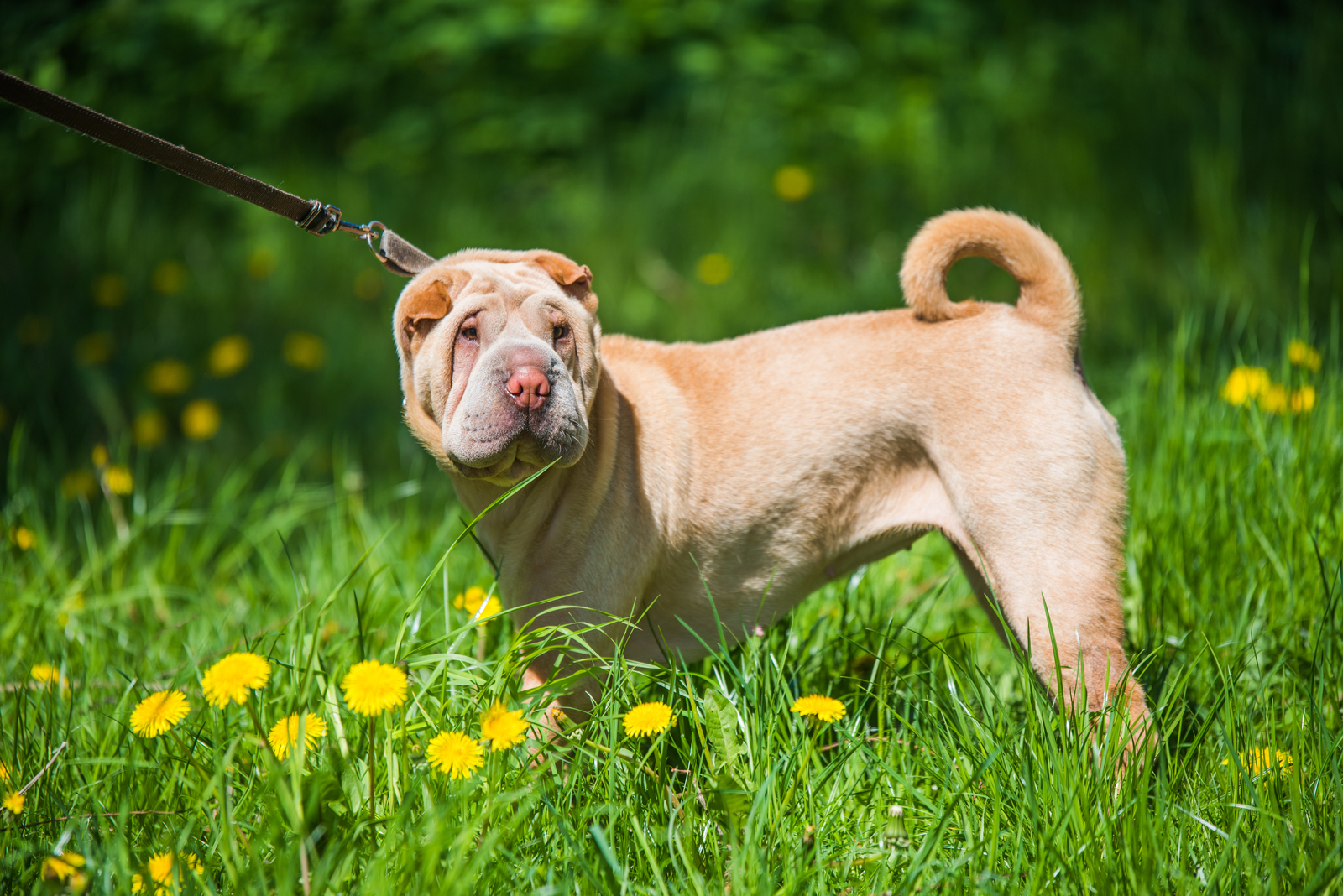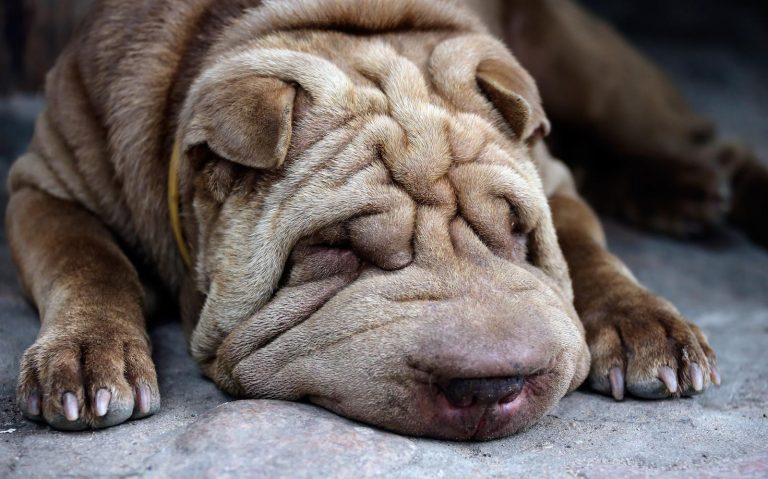The Chinese Shar-Pei and English Bulldog are two distinct dog breeds with unique characteristics. Both have rich histories and loyal followings. The Chinese Shar-Pei originated in China centuries ago. It’s known for its deep wrinkles and blue-black tongue. This breed was initially used for hunting and guarding. English Bulldogs come from the United Kingdom. They were first developed around 1500 and used in bull-baiting. Today’s English Bulldogs are much gentler than their ancestors.
Let’s explore more about these two amazing dog breeds. And, if you’re still on the market to buy a Chinese Shar-Pei or English Bulldog, PuppySpot currently offers a $300 discount using the code PUPPY300, just click the banner below!
Physical Characteristics
Chinese Shar-Peis and English Bulldogs have unique physical traits that set them apart. Their sizes, coats, and distinctive features contribute to their individual charm and appeal.
Size and Weight
- Shar-Peis are medium-sized dogs, standing 18-20 inches tall at the shoulder. Males typically weigh 55-65 pounds, while females weigh 45-55 pounds.
- English Bulldogs are shorter but stockier. They stand 14-16 inches tall. Males weigh 50-55 pounds, and females 40-50 pounds.
- Bulldogs tend to be heavier for their height compared to Shar-Peis. This gives them a more compact, muscular appearance.
Coat and Color
- Shar-Peis have a short, harsh coat that feels rough to the touch. Their coat can be solid or sable in various colors, including fawn, red, cream, and black.
- English Bulldogs have a short, smooth coat. Common colors are brindle, white, red, fawn, and combinations of these. Some Bulldogs have patches or spots.
- Both breeds shed moderately and require regular brushing to keep their coats healthy.
Distinctive Features
Shar-Peis are known for their wrinkly skin, especially as puppies. Adult Shar-Peis retain wrinkles on their face, neck, and shoulders.
Key features of Shar-Peis include:
- Deep-set, almond-shaped eyes
- “Hippopotamus” muzzle shape
- Small, triangular ears
- Blue-black tongue
English Bulldogs have a distinct appearance with:
- Flat, wrinkled face
- Undershot jaw with an upward sweep
- Loose, jowly cheeks
- Wide-set eyes
- Rose or button ears
Both breeds are brachycephalic, meaning they have short muzzles and flat faces. This can lead to breathing issues and other health concerns.

Temperament and Behavior
The Chinese Shar-Pei and English Bulldog have distinct personalities that affect their behavior as pets. Both breeds have unique traits that shape how they interact with people and other animals.
Personality Traits
- Chinese Shar-Peis are independent and reserved. They often bond closely with their family but can be aloof with strangers. These dogs are calm and quiet most of the time.
- English Bulldogs are friendly and outgoing. They love attention and adapt well to family life. Bulldogs are known for their gentle and patient nature, especially with children.
- Both breeds can be stubborn at times. This trait may make training a challenge. Consistent, positive methods work best for both Shar-Peis and Bulldogs.
Social Needs
- Shar-Peis are not highly social dogs. They prefer the company of their family and may not seek attention from others. Early socialization is key to help them accept new people and situations.
- English Bulldogs are more social. They enjoy being around people and other pets. Bulldogs often get along well with children and make great family companions.
- Both breeds can suffer from separation anxiety if left alone too long. Regular companionship and exercise help prevent behavior issues.
Prey Drive and Playfulness
- Shar-Peis have a moderate prey drive. They may chase small animals but are not typically aggressive hunters. These dogs are playful in short bursts but prefer calm activities.
- English Bulldogs have a lower prey drive. They are less likely to chase other animals. Bulldogs enjoy playtime but tire quickly due to their build.
- Both breeds benefit from gentle play and short walks. Interactive toys can keep them mentally stimulated without overexertion.
Adaptability
- Shar-Peis adapt well to different living situations. They can be content in apartments or houses as long as they get enough exercise. These dogs handle changes in routine fairly well.
- English Bulldogs are also adaptable. They thrive in various home types and don’t need much space. Bulldogs are sensitive to extreme temperatures and prefer moderate climates.
- Both breeds do best with consistent routines. They can adjust to new situations with proper introduction and support from their owners.
Territorial Protection
- Chinese Shar-Peis are naturally protective. They make excellent watchdogs and will alert their owners to strangers. Shar-Peis can be territorial and may need training to accept visitors.
- English Bulldogs are less territorial. While they may bark at newcomers, they are generally friendly once introduced. Bulldogs are not typically aggressive but can be protective of their family.
- Both breeds can serve as good watchdogs. Their alertness and loyalty make them attentive to potential threats. Proper training ensures they remain calm and approachable in normal situations.
Care Requirements
Chinese Shar-Peis and English Bulldogs have distinct care needs. Their grooming, exercise, and dietary requirements differ significantly. Let’s explore these aspects in detail.
Grooming Needs
- Shar-Peis need regular brushing to manage shedding. Their wrinkles require cleaning to prevent skin issues. Wipe the folds with a damp cloth and dry thoroughly.
- English Bulldogs also have wrinkles that need attention. Clean their facial folds daily to avoid infections. Brush their short coat weekly to remove loose hair.
- Both breeds need regular nail trims and ear cleaning. Bathe them monthly or as needed. Bulldogs were once fierce but are now gentle companions.
Exercise Demands
- Shar-Peis need moderate exercise. A daily 30-minute walk is usually enough. They enjoy playtime but can be stubborn during training.
- English Bulldogs require less exercise. Short walks and brief play sessions suffice. Their flat faces make them prone to breathing issues, so avoid intense activities.
- Both breeds can overheat easily. Exercise them in cooler parts of the day. Always provide fresh water and watch for signs of exhaustion.
Diet and Nutrition
- Shar-Peis and English Bulldogs need high-quality dog food. Feed them age-appropriate diets suited to their size and activity level.
- Shar-Peis may have food allergies. Monitor their diet closely and consult a vet if skin issues arise.
- English Bulldogs are prone to obesity. Control their portions and limit treats. Avoid foods that cause gas, as Bulldogs are known for flatulence.
- Both breeds benefit from divided meals to prevent bloat. Always provide fresh water. Consult your vet for specific dietary recommendations based on your dog’s needs.
Health and Lifespan
Chinese Shar-Peis and English Bulldogs both face some health challenges. These breeds have average lifespans of 8-12 years. Shar-Peis often deal with skin issues. They can get skin infections and atopic dermatitis. Some Shar-Peis also get a condition called familial Shar-Pei fever.
English Bulldogs have breathing problems due to their flat faces. This is called brachycephalic syndrome. They may snore or have trouble exercising. Both breeds can get hip dysplasia. This is a joint problem that causes pain and limping. They may also develop eye problems like entropion, where the eyelids roll inward. Ear infections are common in both breeds. Their wrinkly skin can trap moisture, leading to these issues.
Some other health concerns include:
- Patellar luxation (kneecap problems)
- Demodectic mange (a skin condition)
- Amyloidosis (protein buildup in organs)
Regular vet check-ups are important for both breeds. Proper diet and exercise can help prevent some health issues. Owners should watch for signs of common problems and seek treatment early.

Training and Intelligence
Both the Chinese Shar-Pei and English Bulldog have unique traits when it comes to training and smarts. These breeds differ in how easily they learn commands and their ability to guard homes.
Trainability and Obedience
- Chinese Shar-Peis can be tricky to train. They have a stubborn streak and like to do things their own way. Owners need to be patient and use positive methods. Early socialization is key for this breed.
- English Bulldogs are a bit easier to train. They aim to please their owners but can be lazy at times. Short, fun training sessions work best for Bulldogs. They respond well to treats and praise.
- Both breeds may struggle in formal obedience trials. The Shar-Pei’s independent nature and the Bulldog‘s laid-back attitude can make competition challenging.
Intelligence Rating
- Chinese Shar-Peis are quite smart dogs. They can solve problems and learn new tasks. But their stubborn side can make them seem less intelligent than they really are.
- English Bulldogs rank lower on dog intelligence scales. They’re not the quickest learners, but they make up for it with their charming personalities. Bulldogs may need more repetitions to grasp new commands.
- Both breeds benefit from mental stimulation. Puzzle toys and training games can help keep their minds sharp.
Watchdog Capability
- Chinese Shar-Peis excel as watchdogs. They’re naturally protective and alert. Shar-Peis will bark to warn their owners of strangers or unusual activity. They can be wary of newcomers and may need extra socialization.
- English Bulldogs are less effective watchdogs. They’re friendly and may welcome intruders instead of scaring them off. Bulldogs will still alert their owners to new sounds or people, but they’re not as vigilant as Shar-Peis.
- Both breeds have low bite risk when properly trained and socialized. Early training is crucial to ensure they’re well-behaved around visitors.



